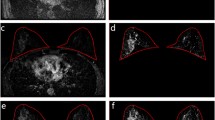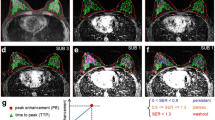Abstract
Objectives
To assess the diagnostic value and contribution to BI-RADS categorisation of initial enhancement on ultra-fast DCE-MRI for differentiating malignant and benign breast lesions.
Methods
The institutional review board approved this study, and written informed consent was obtained from each participant. Both ultra-fast DCE-MRI for initial enhancement analysis and conventional MRI were performed on 200 subjects with a total of 215 lesions (147 malignant and 68 benign). BI-RADS categorisation of enhancing lesions was performed using the conventional MRI. Two initial enhancement measures, time to enhancement (TTE) and maximum slope (MS), were derived from the ultra-fast DCE-MRI. Diagnostic performance and the additional diagnostic value of adding TTE and MS to BI-RADS were evaluated.
Results
Both TTE and MS showed significant differences between malignant and benign breast lesions in masses (TTE, p <.001; MS, p = .006) and non-mass enhancement (NME) (TTE, p <.001; MS, p <.001). For masses, the AUC of TTE+MS combined with BI-RADS (0.864) was better than BI-RADS alone (0.823, p = .065). For NME, the AUC of TTE+MS combined with BI-RADS (0.923) was significantly larger than BI-RADS alone (0.865, p = .036), and diagnostic specificity improved by 40.9% (p = .005), without a significant decrease in the sensitivity (p = .083).
Conclusion
Initial enhancement analysis using ultra-fast DCE-MRI is especially useful for increasing the diagnostic performance of NME in breast MRI.
Key Points
• Ultra-fast dynamic MRI effectively differentiates benign from malignant breast lesions.
• Ultra-fast dynamic MRI contributes to BI-RADS categorisation in non-mass enhancement.
• Management of non-mass breast lesions becomes more appropriate.





Similar content being viewed by others
Abbreviations
- ACR:
-
American College of Radiology
- BI-RADS:
-
Breast imaging reporting and data system
- CI:
-
Confidence interval
- DCIS:
-
Ductal carcinoma in situ
- FOV:
-
Field of view
- GRAPPA:
-
Generalised autocalibrating partial parallel acquisition
- HER2:
-
Human epidermal growth factor receptor type 2
- HR:
-
Hormone receptor
- IDC:
-
Invasive ductal carcinoma
- ILC:
-
Invasive lobular carcinoma
- IQR:
-
Interquartile range
- MS:
-
Maximum slope
- NME:
-
Non-mass enhancement
- TTE:
-
Time to enhancement
- T2WI:
-
T2-weighted imaging
- TWIST:
-
Time-resolved angiography with interleaved stochastic trajectories
- VIBE:
-
Volume-interpolated breath-hold examination
References
American College of Radiology Breast Imaging Reporting and Data System (BI-RADS), vol 2013, 5th edn. American College of Radiology, Reston, VA
Helbich TH, Roberts TP, Gossmann A et al (2000) Quantitative gadopentetate-enhanced MRI of breast tumors: testing of different analytic methods. Magn Reson Med 44:915–924
Gibbs P, Liney GP, Lowry M, Kneeshaw PJ, Turnbull LW (2004) Differentiation of benign and malignant sub-1 cm breast lesions using dynamic contrast enhanced MRI. Breast 13:115–121
Boetes C, Barentsz JO, Mus RD et al (1994) MR characterization of suspicious breast lesions with a gadolinium-enhanced TurboFLASH subtraction technique. Radiology 193:777–781
Sardanelli F, Rescinito G, Giordano GD, Calabrese M, Parodi RC (2000) MR dynamic enhancement of breast lesions: high temporal resolution during the first-minute versus eight-minute study. J Comput Assist Tomogr 24:724–731
Goto M, Ito H, Akazawa K et al (2007) Diagnosis of breast tumors by contrast-enhanced MR imaging: comparison between the diagnostic performance of dynamic enhancement patterns and morphologic features. J Magn Reson Imaging 25:104–112
Kuhl CK, Schild HH, Morakkabati N (2005) Dynamic bilateral contrast-enhanced MR imaging of the breast: trade-off between spatial and temporal resolution. Radiology 236:789–800
Rosen EL, Baker JA, Soo MS (2002) Malignant lesions initially subjected to short-term mammographic follow-up. Radiology 223:221–228
Ikeda DM, Baker DR, Daniel BL (2000) Magnetic resonance imaging of breast cancer: clinical indications and breast MRI reporting system. J Magn Reson Imaging 12:975–983
Malich A, Boehm T, Facius M et al (2001) Differentiation of mammographically suspicious lesions: evaluation of breast ultrasound, MRI mammography and electrical impedance scanning as adjunctive technologies in breast cancer detection. Clin Radiol 56:278–283
Malich A, Fischer DR, Wurdinger S et al (2005) Potential MRI interpretation model: differentiation of benign from malignant breast masses. AJR Am J Roentgenol 185:964–970
Peters NH, Borel Rinkes IH, Zuithoff NP, Mali WP, Moons KG, Peeters PH (2008) Meta-analysis of MR imaging in the diagnosis of breast lesions. Radiology 246:116–124
Dijkstra H, Dorrius MD, Wielema M, Pijnappel RM, Oudkerk M, Sijens PE (2016) Quantitative DWI implemented after DCE-MRI yields increased specificity for BI-RADS 3 and 4 breast lesions. J Magn Reson Imaging 44:1642–1649
Kul S, Cansu A, Alhan E, Dinc H, Gunes G, Reis A (2011) Contribution of diffusion-weighted imaging to dynamic contrast-enhanced MRI in the characterization of breast tumors. AJR Am J Roentgenol 196:210–217
Le Y, Kipfer H, Majidi S et al (2013) Application of Time-Resolved Angiography With Stochastic Trajectories (TWIST) -Dixon in Dynamic Contrast-Enhanced (DCE) Breast MRI. J Magn Reson Imaging 38:1033–1042
Mann RM, Mus RD, van Zelst J, Geppert C, Karssemeijer N, Platel B (2014) A novel approach to contrast-enhanced breast magnetic resonance imaging for screening: high-resolution ultrafast dynamic imaging. Invest Radiol 49:579–585
Mus RD, Borelli C, Bult P et al (2017) Time to enhancement derived from ultrafast breast MRI as a novel parameter to discriminate benign from malignant breast lesions. Eur J Radiol 89:90–96
Tozaki M, Fukuma E (2009) 1H MR spectroscopy and diffusion-weighted imaging of the breast: are they useful tools for characterizing breast lesions before biopsy? AJR Am J Roentgenol 193:840–849
Maltez de Almeida JR, Gomes AB, Barros TP, Fahel PE, de Seixas Rocha M (2015) Subcategorization of Suspicious Breast Lesions (BI-RADS Category 4) According to MRI Criteria: Role of Dynamic Contrast-Enhanced and Diffusion-Weighted Imaging. AJR Am J Roentgenol 205:222–231
Zou GY (2012) Sample size formulas for estimating intraclass correlation coefficients with precision and assurance. Stat Med 31:3972–3981
Matsuoka T, Imai A, Fujimoto H et al (2017) Reduced Pineal Volume in Alzheimer Disease: A Retrospective Cross-sectional MR Imaging Study. Radiology 286:239–248
Faul F, Erdfelder E, Lang AG, Buchner A (2007) G*Power 3: a flexible statistical power analysis program for the social, behavioral, and biomedical sciences. Behav Res Methods 39:175–191
Koo HR, Cho N, Song IC et al (2012) Correlation of perfusion parameters on dynamic contrast-enhanced MRI with prognostic factors and subtypes of breast cancers. J Magn Rson Imaging 36:145–151
Li SP, Padharni AR, Taylor NM et al (2011) Vascular characterization of triple negative breast carcinomas using dynamic MRI. Eur Radiol 21:1364–1373
Imamura T, Isomoto I, Sueyoshi E et al (2010) Diagnostic performance of ADC for Non-mass-like breast lesions on MR imaging. Magn Reson Med Sci 9:217–225
Yabuuchi H, Matsuo Y, Kamitani T et al (2010) Non-mass-like enhancement on contrast-enhanced breast MR imaging: lesion characterization using combination of dynamic contrast-enhanced and diffusion-weighted MR images. Eur J Radiol 75:126–132
Tozaki M, Igarashi T, Fukuda K (2006) Positive and negative predictive values of BI-RADS-MRI descriptors for focal breast masses. Magn Reson Med Sci 5:7–15
Schnall MD, Blume J, Bluemke DA et al (2006) Diagnostic architectural and dynamic features at breast MR imaging: multicenter study. Radiology 238:42–53
Kim SH, Lee HS, Kang BJ et al (2016) Dynamic Contrast-Enhanced MRI Perfusion Parameters as Imaging Biomarkers of Angiogenesis. PLoS One. https://doi.org/10.1371/journal.pone.0168632
Monzawa S, Yokokawa M, Sakuma T et al (2009) Mucinous carcinoma of the breast: MRI features of pure and mixed forms with histopathologic correlation. AJR Am J Roentgenol 192:125–131
Orel SG, Mednonca MH, Reynolds C, Schnall MD, Solin LJ, Sullivan DC (1997) MR imaging of ductal carcinoma in situ. Radiology 202:413–420
Szabó BK, Aspelin P, Kristoffersen Wiberg M, Tot T, Boné B (2003) Invasive breast cancer: correlation of dynamic MR features with prognostic factors. Eur Radiol 13:2425–2435
Baltzer PA, Vag T, Dietzel M et al (2010) Computer-aided interpretation of dynamic magnetic resonance imaging reflects histopathology of invasive breast cancer. Eur Radiol 20:1563–1571
El Khouli RH, Macura KJ, Kamel IR, Jacobs MA, Bluemke DA (2011) 3-T dynamic contrast-enhanced MRI of the breast: pharmacokinetic parameters versus conventional kinetic curve analysis. AJR Am J Roentgenol 197:1498–1505
Yi B, Kang DK, Yoon D et al (2014) Is there any correlation between model-based perfusion parameters and model-free parameters of time-signal intensity curve on dynamic contrast enhanced MRI in breast cancer patients? Eur Radiol 24:1089–1096
Milosevic ZC, Nadrljanski MM, Milovanovic ZM, Gusic NZ, Vucicevic SS, Radulovic OS (2017) Breast Dynamic Contrast Enhanced MRI: Fibrocystic Changes Presenting as a Non-mass Enhancement Mimicking Malignancy. Radiol Oncol 51:130–136
Yuen S, Uematsu T, Masako K, Uchida Y, Nishimura T (2008) Segmental enhancement on breast MR images: differential diagnosis and diagnostic strategy. Eur Radiol 18:2067–2075
Uematsu T, Kasami M (2012) High-spatial-resolution 3-T breast MRI of nonmasslike enhancement lesions: an analysis of their features as significant predictors of malignancy. AJR Am J Roentgenol 198:1223–1230
Funding
This study has received funding by the Japan Society for the Promotion of Science (JSPS) KAKENHI Grant Number JP16K19840.
Author information
Authors and Affiliations
Corresponding author
Ethics declarations
Guarantor
The scientific guarantor of this publication is Mariko Goto MD, PhD, Assistant Professor of the Department of Radiology, Kyoto Prefectural University of Medicine.
Conflict of interest
The authors of this manuscript declare relationships with the following companies: Two of the co-authors (Elisabeth Weiland and Hiroshi Imai) are employees of Siemens Healthcare.
Statistics and biometry
One of the authors (Isao Yokota) has significant statistical expertise.
Informed consent
Written informed consent was obtained from all subjects (patients) in this study.
Ethical approval
Institutional Review Board approval was obtained.
Methodology
• Retrospective
• Diagnostic or prognostic study
• Performed at one institution
Rights and permissions
About this article
Cite this article
Goto, M., Sakai, K., Yokota, H. et al. Diagnostic performance of initial enhancement analysis using ultra-fast dynamic contrast-enhanced MRI for breast lesions. Eur Radiol 29, 1164–1174 (2019). https://doi.org/10.1007/s00330-018-5643-4
Received:
Revised:
Accepted:
Published:
Issue Date:
DOI: https://doi.org/10.1007/s00330-018-5643-4




